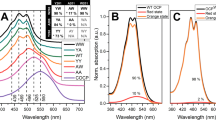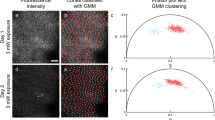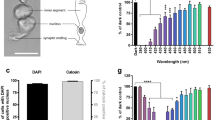Abstract
WE present here a study of the fluorescence and phosphorescence of human eye lenses in vitro with regard to the mechanisms of formation of cataracts. Light transmission by the cornea decreases rapidly with decreasing wavelength, and is essentially zero for wavelengths less than 293 nm1–3. The important effect of this corneal absorption was demonstrated by Bachem3 who induced cataracts in guinea-pigs and rabbits with ultraviolet light and presented an action spectrum to show that the efficiency of in vivo cataract production rose steeply, from zero at 293 nm to maximum at 300 nm, and then fell off sharply at 313 nm with a long tail extending to about 365 nm. This action spectrum and the corneal absorption spectrum are shown in Fig. 1.
This is a preview of subscription content, access via your institution
Access options
Subscribe to this journal
Receive 51 print issues and online access
$199.00 per year
only $3.90 per issue
Buy this article
- Purchase on Springer Link
- Instant access to full article PDF
Prices may be subject to local taxes which are calculated during checkout
Similar content being viewed by others
References
Langham, M., The Cornea (Johns Hopkins Press, 1967).
Boettner, E. A., University of Michigan, Report AF 41(609), 2966.
Bachem, A., Amer. J. Ophthalmol., 41, 969 (1956).
Vladimirov, A., and Litvin, F. F., Biophysics, 5, 151 (1960).
Konev, S. V., Fluorescence and Phosphorescence of Proteins and Nucleic Acids (Plenum Press, New York, 1967).
Rabonovitch, B., Arch. Biochem. Biophys., 124, 258 (1968).
Barenboim, G. M., Biophysics, 8, 209 (1963).
Harris, D. T., Biochem. J., 20, 288 (1926).
Gomyo, T., and Fujimaki, M., Agr. Biol. Chem., 34, 302 (1970).
van Heyningen, R., Nature, 230, 403 (1969).
Pirie, A., Invest. Ophthalmol., 1, 634 (1968).
Davson, H., The Eye, Vegetative Physiology and Biochemistry, 1, 428 (Academic Press, 1969).
Author information
Authors and Affiliations
Rights and permissions
About this article
Cite this article
KURZEL, R., WOLBARSHT, M., YAMANASHI, B. et al. Tryptophan Excited States and Cataracts in the Human Lens. Nature 241, 132–133 (1973). https://doi.org/10.1038/241132a0
Received:
Revised:
Issue Date:
DOI: https://doi.org/10.1038/241132a0
This article is cited by
-
Phototoxicity of environmental radiations in human lens: revisiting the pathogenesis of UV-induced cataract
Graefe's Archive for Clinical and Experimental Ophthalmology (2019)
-
Non-enzymatic glycation of α-crystallin as an in vitro model for aging, diabetes and degenerative diseases
Amino Acids (2015)
-
Paramagnetic species in cataractous human lenses
Nature (1975)
Comments
By submitting a comment you agree to abide by our Terms and Community Guidelines. If you find something abusive or that does not comply with our terms or guidelines please flag it as inappropriate.



